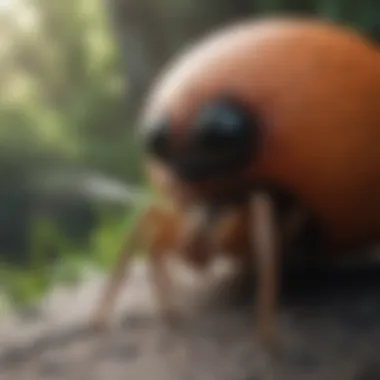Understanding Spider Egg Killer Spray: Comprehensive Guide


Intro
When it comes to battling unwelcome arachnids in our homes, knowledge is our best ally. Spider egg killer sprays are often one of the first lines of defense homeowners consider. Yet, not every can of bug spray is created equal. This article aims to unravel the ins and outs of these products, delving deep into their composition, effectiveness, and safe usage practices. In navigating the world of spider control, we will uncover the different formulations available, how they work, and the simple methods you can employ to address an infestation before it spirals out of control.
Pest Identification
Understanding what you're up against is crucial when dealing with pests. If you’re spotting these little eight-legged creatures, it’s likely time to investigate further. Spider species are many and varied, but a few common culprits tend to invade homes more frequently.
Detailed Descriptions of Common Pests
- Black Widow Spider: Recognizable by its glossy black body and distinctive red hourglass shape on the abdomen, the Black Widow exudes a potency that makes it crucial to identify promptly. They often prefer dark, secluded areas, like woodpiles or basements.
- Brown Recluse Spider: Often mistaken for other common spiders, the brown recluse has a violin-shaped mark on its back. It seeks out cluttered spaces in homes, making it a cause for concern. Their bite can lead to serious health issues, so knowing their habits is vital.
- Orb-Weaver Spider: These are relatively harmless. With their colorful patterns and large webs, they may physically draw attention, but they can help control other insects in your home.
Signs and Symptoms of Infestations
Look around your home; it often speaks volumes. Common indicators of a spider infestation include:
- Webs in corners or behind furniture.
- Egg sacs, sometimes appearing as small, white or translucent globes.
- Increased sightings of adult spiders in living areas, particularly at night.
It’s important to tackle these issues early, so your home doesn't turn into a spider sanctuary.
Prevention Strategies
A stitch in time saves nine – and the same goes for spiders. Preventing them from entering your home in the first place can save you time and headache.
Home Maintenance Tips for Pest Prevention
- Seal Entry Points: Cracks around windows and doors can be inviting for spiders. Regularly check and caulk gaps to keep them out.
- Maintain Cleanliness: Regular sweeping and decluttering can minimize spider habitats. Take a good look under furniture and within storage areas.
- Trim Vegetation: Keep plants and bushes trimmed away from the foundation of your home to limit the highways spiders use to gain access.
Natural Deterrents and Barriers
While chemical sprays are often the forefront in the fight against pests, natural methods play a valuable role:
- Essential Oils: Spiders tend to detest scents like peppermint or citrus. Creating a diluted spray with water might keep them at bay.
- Diatomaceous Earth: This natural powder can be sprinkled around entry points; it works to dehydrate and kill spiders when they come into contact with it.
Treatment Options
If prevention methods haven't worked and you're facing an invasion, it’s time to delve into treatment options.
Overview of Chemical vs. Natural Treatments
When analyzing spider egg killer sprays, you’ll find options that range from chemical formulations to natural ones. Chemical sprays often promise quick results but may come with risks. In contrast, natural alternatives might take longer but can be safer for family and pets.
Step-by-Step Guides for DIY Treatments
For those inclined to take matters into your own hands, here’s a basic approach for a DIY spider spray using everyday household items:
- Gather Materials: You’ll need a spray bottle, water, dish soap, and your choice of essential oil.
- Mix Ingredients: Combine one cup of water, a teaspoon of dish soap, and about 10-15 drops of essential oil in the spray bottle.
- Application: Shake well and spray into corners, around windows, and other suspicious areas.
Using this homemade solution can reduce the likelihood of pests re-announcing their presence. Always test on small areas first to avoid any unwanted reactions.
Understanding and addressing spider infestations requires a range of strategies. From identification to prevention and treatment, knowledge equips you to take effective action.
In the forthcoming sections, we will further dissect spider egg killer sprays and unveil how to choose the right product based on your situation.
Preface to Spider Egg Killer Spray
In an age where home pest control has become a necessity, understanding the tools at our disposal, like spider egg killer sprays, is vital. These products are not just another addition to your cleaning arsenal; they are a targeted solution designed to deal with a common but often overlooked problem—spider infestations. In this section, we will explore what these sprays are, why they matter, and the critical factors surrounding their use.
Defining Spider Egg Killer Spray
Spider egg killer spray is a specially formulated insecticide aimed at eliminating spider eggs before they hatch into the adult pests that can invade your home. While it’s tempting to reach for any old bug spray, these products are distinctly designed to disrupt the life cycle of spiders, ensuring that potential infestations are halted before they even start. Usually packaged in easy-to-use spray bottles, they offer homeowners a straightforward method to tackle a troublesome issue without resorting to extreme measures. The active ingredients in these sprays vary widely but generally focus on targeting the dormant eggs rather than adult spiders themselves.
Purpose and Importance
The purpose of spider egg killer sprays goes beyond mere extermination. They serve to safeguard our living spaces from unwanted spiders, which not only can be a nuisance but also pose risks—some spiders may carry venom that could be harmful, although most species are harmless.


Being proactive in pest management is crucial, as the old adage goes, "an ounce of prevention is worth a pound of cure." By addressing spider eggs early, one can prevent a full-scale infestation, which can be not only annoying but also costly in terms of time and money spent on remediation.
Moreover, understanding the importance of using a product designed specifically for spider eggs allows homeowners to prioritize safety and effectiveness in their pest control efforts. Awareness about this specific approach promotes responsible usage and safeguards health and environment by reducing chemical overuse.
"Taking action against unwanted pests at the egg stage saves worry and wear in the long run."
Components of Spider Egg Killer Spray
Understanding the components that make up spider egg killer spray is crucial in grasping how these products function. Homeowners are often quite concerned about what goes into these formulations, mainly due to health implications for their families and pets. The choice between different components can affect not only the effectiveness of the spray but also its overall safety and environmental footprint. Thus, it's vital to delve into the key ingredients commonly used and the distinctions between natural and synthetic formulations.
Chemical Ingredients
The chemical ingredients in spider egg killer sprays can vary widely between different brands and formulations. These chemicals often serve specific purposes, such as ensuring quick efficacy, prolonging shelf-life, or enabling safe application. Here are several main chemical components you'll frequently encounter:
- Pyrethroids: These are synthetic chemicals modeled after chrysanthemum flowers. They disrupt a spider's nervous system, leading to quick paralysis and eventual death.
- Insect Growth Regulators (IGRs): IGRs prevent immature spiders from developing into adults, which can effectively break the reproductive cycle. This means even if some adults escape initial treatment, their offspring will not survive to adulthood.
- Sodium Lauryl Sulfate: Often used as a surfactant, it helps the spray spread more effectively across surfaces. It can enhance the penetration of other active ingredients.
"Understanding the chemical components can help you make informed choices about pest control without compromising your health or the environment."
Each of these ingredients plays a role in creating a more potent and effective spider egg killer spray. However, it's important to note that the concentration of these chemicals can differ between products, influencing their effectiveness.
Natural versus Synthetic Formulations
The market offers various formulations when it comes to spider egg killer sprays, often categorized as natural or synthetic. The differences between these types are substantial and deserve closer inspection, especially for health-conscious homeowners.
Natural Formulations: These sprays often incorporate plant-derived ingredients, such as neem oil or peppermint oil. Here are some considerations for natural formulations:
- They may be less effective on mature spiders but are usually safer for both humans and pets.
- These formulations often have a pleasant scent, which can be appealing in household usage.
- They tend to break down more quickly in the environment, minimizing ecological impact.
Synthetic Formulations: While typically more effective against a wider variety of spider species, they come with trade-offs:
- These sprays can pose a higher risk of harmful exposure to humans or pets, particularly if proper safety measures aren’t observed.
- They may have a longer shelf life but can also accumulate in the environment, potentially harming non-target insect populations.
When choosing between natural and synthetic sprays, consider the context of usage, your household setup, and individual preferences. For instance, while a synthetic option might deliver faster results, a natural product could be preferable for regular use in a home with children and pets.
Combining knowledge of the components and understanding the formulation types can empower homeowners to make strategic choices consistent with their pest control needs.
Efficacy of Spider Egg Killer Spray
The effectiveness of spider egg killer spray takes center stage in our discussion about pest control strategies. This is not simply about wanting a clean home; it's about safeguarding your living space from a potentially overwhelming spider infestation. When spiders reproduce, they can yield many eggs, and a single egg sac can house hundreds of tiny spiders. This means that having an effective method to eliminate these eggs is essential to keeping the creepy-crawlies in check. In this section, we’ll delve into how these sprays work, how they measure up against different spider species, and the best ways to apply them for maximum effect.
How It Works
Understanding how spider egg killer spray functions gives one insight into their efficacy. The spray typically contains active ingredients designed to penetrate the egg sac's protective layer. Once applied, it disrupts the development of the embryos inside, leading to their eventual demise. This mechanism addresses not just the adult spiders that might be lurking about but targets the very source of future infestations.
Utilizing these sprays isn't merely spraying and forgetting. The timing and method of application play pivotal roles in the results you might achieve. Using it when spiders are actively laying eggs, for instance, might yield better results compared to spraying haphazardly.
Comparative Effectiveness
The comparative effectiveness of spider egg killer sprays reveals a landscape of choices, each with unique advantages.
Spray Performance on Different Spider Species
When it comes to spray performance against different spider species, not all sprays are created equal. Some formulations may be specifically tailored to certain types of spiders, while others claim broader effectiveness. For example, some products excel at targeting common household spiders like the house spider or the black widow due to their specific chemical formulations. This targeting is beneficial because homeowners can focus their efforts on the spider species they most likely encounter.
A unique feature here is the spray's ability to function as a preventative measure. For instance, most effective formulations don't just kill; they often also create a barrier that deters further egg-laying in the vicinity. This dual function makes certain sprays a popular choice for those who prioritize long-term pest management.
Application Methods and Outcomes
The application methods used for spider egg killer sprays significantly influence their outcomes. A consistent characteristic of effective sprays is the method of deployment. Varying techniques, from traditional aerosol to handheld pump sprays, can yield different results in application. For example, aerosol sprays may cover larger areas quickly, while pump sprays provide targeted application where it’s needed most.
A unique facet of how these sprays perform is their reach. Longer nozzles can help in accessing hard-to-reach corners, a common hiding spot for spiders and their eggs. However, a disadvantage may come from the overspray that can sometimes occur with aerosol methods, rendering surfaces that were not intended for spraying inadvertently treated, which could raise safety concerns in homes with children or pets.
"A thorough application technique directly correlates with the effectiveness of pest control measures."
In summary, grasping the efficacy of spider egg killer sprays encompasses understanding how they work, comparing their performances against various spider species, and adopting suitable application methods. Recognizing these aspects equips homeowners with the knowledge they require to manage spider infestations proactively.
Application Techniques for Maximum Impact


When it comes to controlling spider populations in and around the home, knowing how to effectively apply spider egg killer spray can be the difference between a thorough cleanup and a half-hearted attempt that leaves you with lingering concerns. Application techniques influence not only the efficacy of the product but also the scope of its impact, making this a critical part of any pest control strategy.
Preparation for Application
Before reaching for that spray can, it’s crucial to prepare adequately. This means ensuring that the area you plan to treat is ready for effective application. Start by removing any clutter or obstacles where spiders may hide. Dust and wipe surfaces clean; spiders have a knack for finding those ignored corners. Next, read the product label thoroughly to understand the specific instructions regarding dilution, if applicable, and the recommended personal protective equipment. It’s also wise to choose a day when the weather is calm and dry. Avoid windy days that can send your spray drifting off target.
Best Practices in Application
When you’re set to apply the spray, keep the following best practices in mind to maximize its effectiveness:
Timing Considerations
Timing plays a crucial role in pest control, impacting the level of success you achieve with spider egg killer sprays. Applying these sprays during the early morning or late evening can be particularly effective. At these times, spiders are often more active and present in their habitats. Dusk and dawn provide a unique opportunity, as sunlight can drive these pests into hiding—making nighttime applications an overlooked gem. Additionally, consider treating just before a weather event that includes moisture; spiders tend to roam for new shelter during rain, making them vulnerable to your spray.
Unfortunately, spraying during the day might lead to evaporation of the product, reducing its efficiency. Consider the temperature and wind; both can greatly impact how the product will settle and work. Timing is not merely a detail; it’s a game changer that can elevate your pest control efforts.
"Effective pest management hinges not just on what you use, but when you choose to deploy it."
Target Areas for Spraying
Identifying the right target areas is fundamental to achieving maximum impact with spider egg killer spray. Focus on places where spiders are likely to dwell: corners, under furniture, and along baseboards are often hotspots for these eight-legged creatures. Think about entry points, too; door frames, window sills, and any crack or crevice can serve as gateways for unwanted visitors.
What’s unique about targeting these areas is that they often overlap with the spider’s natural behavior; they tend to hide in places that are dark and damp. Directly treating these locations increases the likelihood of contact with the spray. However, it’s essential to avoid applying too heavily, as this might lead to runoff or blotches. A more focused approach always pays off.
Safety Concerns and Environmental Impact
When it comes to choosing pesticides for home use, it's crucial to consider safety concerns. Spider egg killer sprays might promise effective results in tackling those pesky webs and unwanted critters, but understanding their potential impact on health and the environment is equally important. By highlighting these aspects, homeowners can make informed decisions and ensure a safer living space.
Health Risks to Humans and Pets
Symptoms of Exposure
Exposure to the chemicals in spider egg killer sprays can lead to various health issues. The most common symptoms include respiratory problems, skin irritation, and even headaches. While manufacturers often detail the risks on their product labels, many consumers overlook this crucial information.
Interestingly, sensitivity to these chemicals can vary significantly among different individuals. For example, people with allergies might experience worsened symptoms upon exposure. This variability is especially important to consider for households with pets or children, who might be more vulnerable. Therefore, having a clear understanding of the potential symptoms of exposure helps in anticipating any adverse effects.
Precautionary Measures
Employing precautionary measures can significantly reduce the health risks associated with spider egg killer sprays. First and foremost, wearing protective gear, such as masks and gloves, is highly recommended during application. This simple step not only minimizes direct skin contact with the spray but also helps in preventing inhalation of harmful fumes.
Additionally, proper ventilation in the area where the spray is used can alleviate some concerns. Opening windows and doors allows airborne chemicals to disperse more quickly, providing a safer environment. It’s worth mentioning that careful planning around application timing, like avoiding hot, humid days when dispersal is greatest, can further enhance safety.
Ecological Considerations
Impact on Non-target Species
Another factor to consider is the impact of spider egg killer sprays on non-target species. Most pest control products, while effective against the intended targets, often have unintended consequences on beneficial insects. For example, bees and butterflies may be adversely affected by broad-spectrum sprays, disrupting the surrounding ecosystem. This matters not just for gardening enthusiasts but for anyone who values biodiversity in their area.
Targeted sprays, which focus on specific pests, can minimize this impact drastically. Opting for such alternatives encourages a healthier ecosystem while still tackling unwanted spiders.
Biodegradability of Ingredients
The biodegradability of ingredients used in spider egg killer sprays plays a significant role in their environmental footprint. Products containing natural or less synthetic components are often more favorable, as they break down more easily in the environment. Synthetic chemicals, conversely, may linger in soil and water supplies, potentially posing risks long after their application.
Choosing sprays with eco-friendly labels can provide peace of mind for homeowners seeking to minimize their environmental impact. Not only does it reflect a responsible approach to pest management, but it can also maintain the integrity of local wildlife habitats.
To summarize, when selecting a spider egg killer spray, consider the health risks, precautionary measures, and ecological impacts. Making informed choices can lead to effective pest control without compromising safety and environmental well-being.
Alternatives to Spider Egg Killer Spray
The topic of alternatives to spider egg killer spray is crucial for homeowners looking for effective pest control options. While spider egg killer sprays can provide immediate results, some individuals might prefer methods that align with personal values, such as seeking more natural solutions or minimizing chemical exposure. Knowing the alternatives allows for a comprehensive and informed approach that fits various needs and circumstances.
Natural Repellents
Natural repellents stand out as a popular alternative due to their eco-friendliness and minimal health risks. Ingredients such as peppermint oil, vinegar, and diatomaceous earth can deter spiders effectively without the harmful side effects associated with synthetic chemicals. These options resonate with homeowners who are concerned about their family's health or the environment.
One notable example is the use of essential oils. For instance, a mixture of water and a few drops of peppermint oil can create a strong spider repellent. Not only does it smell pleasant, but it also effectively repels spiders. However, it's essential to understand that while their effectiveness may vary, these methods require more frequent application and may not work as quickly as chemical sprays.


Mechanical Methods
Mechanical methods provide tangible solutions to spider infestations and come with the added benefit of being chemical-free. They can range from simple traps to more active approaches such as vacuuming. Let's dive a bit deeper into two subdivisions of mechanical methods: traps and barriers, and vacuuming techniques.
Traps and Barriers
Traps and barriers can be highly beneficial in controlling spider populations without the need for chemicals. By setting up sticky traps or using physical barriers like mesh screens, homeowners can keep unwanted spiders at bay effectively. One key characteristic of these methods is their ability to capture spiders without direct contact, which is especially appealing for those nervous about handling live spiders.
The unique feature of these traps is that they can provide a visual indication of spider activity, which helps in assessing whether further measures are necessary. A downside is that they require regular monitoring and can be less effective against larger spider populations if not consistently managed. Overall, traps and barriers offer a practical and straightforward way to alleviate spider concerns in homes.
Vacuuming Techniques
Vacuuming techniques are another critical aspect of mechanical methods and contribute significantly to pest control endeavors. This approach not only allows the removal of spiders but also targets their webs and egg sacs, hindering any chance of future infestations. A vacuum cleaner can quickly capture spiders hiding in corners or crevices, making it a highly effective choice for immediate action.
The key characteristic of vacuuming techniques is their accessibility; most households already own a vacuum cleaner. This method is often preferred because it provides immediate results without leaving any lingering chemicals in the environment. However, care must be taken to empty the vacuum bag or canister afterward to prevent any captured spiders from escaping.
Vacuuming is a safe and effective way to reduce spider populations, and it leaves behind no harmful residues that may affect the family or pets.
In summary, exploring alternatives to spider egg killer spray allows homeowners to tailor their pest control approaches to their personal preferences and environmental considerations. Whether through natural repellents or practical mechanical methods like traps and vacuuming, these alternatives offer effective means to manage spider populations while promoting a safer living environment.
Best Practices in Pest Control
Effective pest control does not just revolve around using spray products haphazardly. It involves a strategic approach that takes into account various factors to ensure pest issues are managed sustainably and safely. When it comes to handling pest issues including spiders, knowing the best practices can save you time, money, and unnecessary headaches.
Integrating Various Control Methods
Integrating multiple pest control methods can significantly enhance effectiveness. This means utilizing both chemical and natural remedies rather than relying on one method alone. Combining these strategies can create a holistic approach that not only targets current infestations but also prevents future ones. For instance, while spider egg killer spray can effectively eliminate existing spider populations, natural repellents, such as essential oils, can discourage their return. This synergy ensures that homeowners lessen their dependency on harsh chemicals while still being proactive in pest management.
Using a diverse arsenal of strategies means considering factors like:
- The types of pests involved
- The environment where the treatment takes place
- Safety of children and pets
By taking these elements into consideration, homeowners can tailor their approach to serve both their immediate needs and long-term goals for pest control, tackling the problem from multiple angles.
Regular Monitoring and Maintenance
Regular monitoring is crucial in keeping pest problems at bay. Pest populations can explode in no time if not kept in check. Early identification of infestations can make all the difference. Homeowners should routinely check areas like the attic, basement, and other dark corners which are prone to spider nesting.
Identifying Infestations Early
Identifying infestations early is about being observant and aware of changes in your environment. This vigilance can lead to early detection of spider eggs or webs, which often indicate a growing problem. Recognizing these signs can help prevent larger infestations that take more time and resources to eradicate.
The key feature of early detection is that it allows for timely interventions. Addressing a smaller problem is always more cost-effective than dealing with a full-blown infestation. Homeowners may notice:
- Increased web formation in corners
- Actual sightings of spiders, especially in unexpected areas
By understanding these early signs, homeowners can act swiftly. The benefits are significant — less chemical use, lower costs, and a healthier living space.
Environmental Management Techniques
Environmental management techniques focus on modifying the environment to dissuade pests from thriving. This aspect is essential as it targets the root cause rather than just the symptoms. One effective technique is to reduce clutter in and around the home, which can serve as prime hiding spots for spiders.
A significant characteristic here is creating an unsuitable habitat for spiders. Techniques may include:
- Sealing cracks and holes in walls or foundations
- Maintaining yard cleanliness by trimming shrubs and mowing grass regularly
The unique advantage of such techniques is their sustainability; these changes can result in long-lasting effects on pest control. Moreover, they tend to be low-cost solutions. Homeowners would find that by creating a less inviting space for pests, the need for chemical applications either diminishes or becomes unnecessary.
Ending
In wrapping up our comprehensive look at spider egg killer spray, it’s crucial to highlight several pivotal elements that serve both homeowners and pest control professionals. Understanding how these sprays function, their composition, and their safety parameters is not just academic; it translates directly into practical knowledge in the realms of pest management. Most importantly, it arms individuals with the ability to make enlightened choices, balancing effectiveness with responsible usage.
Recap of Key Points
- Composition Matters: The key ingredients in these sprays, whether synthetic or natural, determine both efficacy and safety. Knowledge of the chemical makeup can guide users in selecting the right product.
- Efficacy Evaluated: Recognizing how these sprays operate gives users a clearer picture of what to expect. Application methods play a significant role in the overall effectiveness of the spray, especially regarding specific spider species.
- Safety Considerations: Personal safety, particularly for families with pets or small children, should never be an afterthought. Keeping informed about potential health risks and the environmental impact of the chosen spray is essential.
- Alternatives Exist: Not all pest control measures need to involve sprays. Understanding natural remedies and mechanical methods offers a broader toolkit for those seeking to minimize spiders around their homes.
Final Thoughts on Usage
The importance of responsible use of spider egg killer sprays cannot be overstated. While these products can provide significant benefits in pest control, it's imperative to approach them with caution and mindfulness. Always read labels thoroughly and follow the manufacturers' instructions. Proper application ensures not only a more effective outcome but also fosters an environment that limits unintended consequences to non-target species and the surrounding ecosystem.
Remember, pest management is not a one-size-fits-all solution. Regular monitoring of your living space, combined with a varied approach to pest control, can be far more effective than reliance on a single method. It empowers users to create safer, cleaner homes while addressing immediate pest issues. For those dealing with spider infestations, informed and thoughtful application of these sprays can yield favorable results.
The key to effective pest control lies not just in the product used, but in the understanding of its comprehensive application and environmental ramifications.



